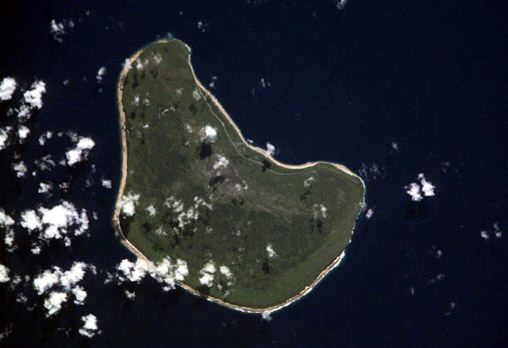Makatea

- ISS002-E-7426
- 19 June 2001
- 20:07 UTC
Makatea, located in the northwest of the archipelago, is one of only four islands among the islands of the archipelago that do not to take the form of a true atoll. Instead, Makatea is a raised atoll formation (or makatea), forming a raised coral island structure. The island is located 79 km southwest from Rangiroa and 74 km directly southwards from Tikehau.
The island, measuring 7.5 km north to south, rises spectacularly from the sea in a vertical cliff of up to 80 m in height. The cream to white coloured cliffs represent hundreds of thousands of years of coral growth that took place before the island was geologically uplifted. Changing sea levels at the end of the last ice-age have also contributed to the islands emergence. The interior of the island is a mostly flat plateau of 24 km².
The plateau supports a dense, tall forest dominated by Pisonia grandis, Screwpine (Pandanus tectorius), Banyan or Strangling Fig (Ficus prolixa), Homalium moua (a member of the Indian Plum family), Beach Gardenia (Guettarda speciosa), and the endemic palm Pritchardia vuyltekeana. The island is home to the Polynesian pigeon (Ducula aurorae), which survives in small numbers as well as the Makatea Fruit-dove (Ptilinopus chalcurus) and Tuamotu Reed-warbler (Acrocephalus atypha).
In this near-vertical image, the cliffs of the island can't be seen clearly — except as a dark shadow around the southern coasts. However, the broad reef flat that lies adjacent to the cliffs can be seen as a cream-coloured band around most of the island. The combination of cliffs and the close-hugging reef make access to the island difficult.
image: earth sciences and image analysis laboratory, nasa johnson space center

